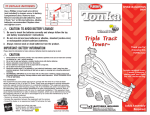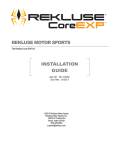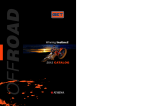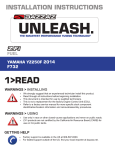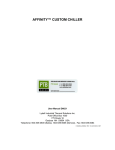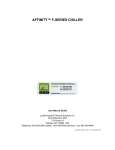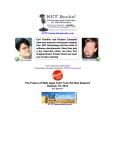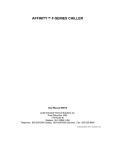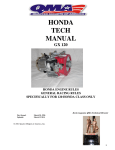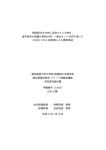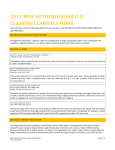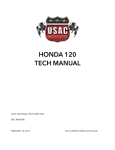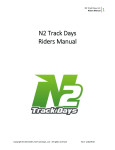Download 2014 rulebook - Granite State Mini Sprints
Transcript
GRANITE STATE MINI SPRINT RACING CLUB, INC. 2014 RULEBOOK REVISED APRIL 1ST 2013 TABLE OF CONTENTS PAGES FOREWORD 3 DISCLAIMER 3 ARTICLES OF AGREEMENT 3–4 BY‐LAWS 4–6 CHASSIS SPECS 7 – 11 250CC ENGINE RULES 12 – 13 500CC ENGINE RULES 14 – 15 600CC ENGINE RULES 16 – 18 DRUGS & ALCOHOL 19 SAFETY RULES 20 – 21 COMPETITION RULES 21 PROTESTS 22 MEMBERSHIP FEES 22 LINE‐UP PROCEDURE 23 POINTS SYSTEM 23 RACING RULES 24 – 25 FLAGS 26 REVISIONS 27 2|P a ge FORWARD The Board of Directors: The Board of Directors is pleased to present this rulebook in anticipation that it will allow all competitors and associates an equal opportunity to enjoy our sport of mini‐sprint racing. The members of the Granite State Mini‐Sprint Racing Club, Inc., compete in cars utilizing motorcycle engines and drive components. Their specifications are restrictive in order to emphasize driver ability rather than design or preparation of the car. The club is a non‐profit, family oriented organization dedicated to the enjoyment of mini‐sprint racing. The clubs' format provides a high level of camaraderie and opportunities for racers to share a wealth of knowledge and assistance. It has been proven that those who follow the rules and regulations have the most successful operations. Therefore, we urge everyone to do his or her part in making this rulebook workable. We realize that there are certain circumstances that make local track rules necessary, however, these rules should be held to a minimum and they should be printed and posted in such a manner that all competitors shall have full knowledge of them. The club cannot assume responsibility for enforcement or interpretation of these rules. All meetings of the Board of Directors are open to the general membership. DISCLAIMER All racecars competing with the Granite State Mini‐Sprint Racing Club, Inc. must be constructed and equipped according to these guidelines. The rules set forth are designed for the orderly conduct of racing events and to establish minimum acceptable requirements for such events. No expressed or implied warranty of safety shall result from the publication of, or compliance with these rules and/or regulations. They are intended as a guide for the conduct of the sport and are in no way a guarantee against injury or death to participants, spectators or others. ARTICLES OF AGREEMENT OF THE GRANITE STATE MINI‐SPRINT RACING CLUB, INC. A New Hampshire Non‐Profit Organization ARTICLE 1: The name of the corporation shall be: The Granite State Mini‐ Sprint Racing Club, Inc. ARTICLE 2: The object for which this corporation is established is; to promote the sport of mini‐sprint racing and to further the interests of owners, builders and drivers of this type of racing vehicle. The primary considerations shall be safety, sportsmanship and fair play. 3|P a ge ARTICLE 3: The provision for disposition of the corporate assets in the event of the dissolution of the corporation are; should this organization be dissolved, all funds and assets of this organization shall be turned over to charity. The Board of Directors shall determine which charitable organization shall receive the funds. ARTICLE 4: The address at which the business of this corporation is to be carried on is PO Box 662 Center Ossipee NH, 03814 ARTICLE 5: The amount of capital stock if any or the number of shares none. ARTICLE 5‐A: The personal liability of a director, an officer or both to the corporation or its members for monetary damages for breach of fiduciary duty as a director, an officer or both is none, except with respect to; (1) Any breach of the directors' or officers' duty of loyalty to the corporation or its members. (2) Acts or omissions, which are not in good faith or which involve intentional misconduct or a knowing violation of the law. (3) Any transaction from which the director, officer or both, derived an improper personal benefit. ARTICLE 6: Signatures and post office addresser of each of the persons associating together to form the corporation shall be on file with the club secretary. BY‐LAWS ORGANIZATION: 1. The by‐laws of the club shall be adopted by a two/thirds (2/3) majority action of the Board of Directors. The power to alter, amend or repeal the bylaws or to adopt new by‐laws, subject to repeal or change by two/thirds (2/3)‐majority action of the membership, shall be vested in the Board of Directors. The by‐laws may contain any provisions for the regulation and management of the affairs of the club not inconsistent with the laws of the state of New Hampshire or the articles of agreement. 2. Meetings shall be conducted according to Roberts Rules of order. 3. There shall be at least three (3) general meetings in each calendar year. There shall be at least six (6) Board of Directors meetings in each calendar year. The club president may call additional meetings if necessary. MEMBERSHIP: A. Must be an active member to participate in any sanctioned event. ‐ Active members: driver or owner ‐ voting ‐ Temporary member: one time fee one race, ‐ non‐voting. 4|P a ge B. Members thirteen (13) years of age may be allowed to race in the 250/500cc class. B2. Also eligible: 12 year olds with verifiable race experience. They will start at the back of the races, behind the rookies, and will not interfere with points cars. At the discretion of the board, they may be terminated if found not able to compete at the GSMSRC level. B3. Members must be sixteen (16) years of age to race in the 600cc class, fifteen (15) providing they have verifiable (organized competition) racing experience. C. Members shall be of good moral character and reputation, with a genuine interest in the sport of mini‐sprint racing. D. Only active members shall be allowed to vote. Any active member unable to attend a voting meeting may cast an absentee vote with a member of the Board of Directors. E. Only active members shall hold an office of the club. F. All membership applications must be approved by the Board of Directors and cars will be teched. G. An “active” member is a member that has paid their annual dues in full. H. The term of membership begins and terminates on March 15th annually. The officers of the club shall authorize club action and activities. They shall act as and be referred to as the Board of Directors. The officers of the club shall be the President, the Vice President, the Secretary, the Treasurer, the Head of Tech, and the Members at Large. The number of Members at Large will be decided at the annual meeting. Duties of the Officers: 1. The President, as chief officer, shall preside over club meetings, and shall promote and coordinate activities for the general welfare of the club. 2. The Vice President shall perform the duties of the President in the event of his/her absence. 3. The Secretary shall exercise general supervision of the business affairs and correspondence of the club. The Secretary shall record the minutes of all meetings and shall be the custodian of all the club records and also keep track of all championship points for all drivers and all series. 4. The Treasurer shall be responsible for the collection of all monies due the club and subsequent bank deposits and shall make all payments for all club obligations and shall report on the financial condition of the club at all meetings. 5. The Head of Tech’s shall be responsible for the supervision of technical aspects of the competition, pre and post-race technical inspection of competitor’s cars, engines, fuel, research 5|P a ge and developments of any new technical components or ideas, and decision making along with the board of directors on any technical rules infractions. 6. The Members at Large shall act as the members' representatives on the Board of Directors. As the members' representatives, the Members at Large shall promote communication between the Board of Directors and the general membership. 7. Records: All club records are open to inspection by any active member with a reasonable notice. 8. Expenditures: The Board of Directors shall have the authority to spend up to the amount of one thousand dollars ($1,000.00) on other than organizational business. Expenditures in excess of one thousand dollars ($1,000.00) will require a majority vote of the general membership. 9. Dues: Dues must be paid in full by March fifteenth (15th) to retain your present active status including your number. 10. See Revision page. Numbers: All available numbers will be given out on a first come first serve basis after March fifteenth (15th) as long as the member has a racecar. 11. Elections: A. All elected positions shall be for term of one (1) year. The term shall begin directly following the elections. B. Elections for Officers and Members at Large shall be at the first general meeting of the new season. The active board has the authority to choose the date of the first general meeting, at which elections will take place for the new season. The date of the first general meeting will be determined at midseason of the current year. The meeting will be no later than the second week of November. 12. Rules and Regulations: A. The Board of Directors shall be responsible for enforcing competition, technical and safety rules. B. All rules and regulations shall be designated by the Board of Directors and any suggestions shall be to the board in writing or in person at a scheduled board meeting. 13. Vacancy on the Board of Directors: Any vacancy on the Board of Directors created by resignation, death or other will be filled at the discretion of the Board of Directors. 6|P a ge CHASSIS SPECS: All cars are subject to mandatory pre‐season and periodic technical inspection anytime during the racing season. WEIGHT & DIMENSION ‐ ALL CLASSES: The minimum weights with driver: 250cc ‐ 4 Stroke 675 lbs 500cc (Stock Pistons) 675 lbs 500cc (Dome Dimple or Fly cut)* 725 lbs 600cc 775 lbs MAX. Left or right side weight bias Wheelbase center to center 60% Min 55" Max 70" Car width from sidewall to sidewall 250/500cc 61” 600cc 65” 1. Car Weigh‐In: Top 4 cars in each feature must go straight to scales and weigh in. If a driver runs in both classes and finishes in the top 4 in the first car, that car must be placed by the scales until driver finishes the second race. A. Penalty: Any racecar weighing less than the legal minimum weight with driver will result in disqualification and loss of points for the night. B. Ballast ‐ All Classes: Any material used for the purpose of adding weight to the racecar shall be securely attached as part of the car’s structure. No liquid or loose ballast shall be allowed. (i.e.. oil, fuel, sandbags, rocks, etc.) 2. Frame/Chassis/Roll Cage ‐ All Classes: The frame/chassis assembly shall be constructed of tubing and shall follow accepted upright sprint/midget design. All bends in the tubing shall have a radius of no less than three (3) inches. No point corners shall be permitted. 7|P a ge The frame/chassis shall have sufficient fore and aft bracing and triangulation. The main hoop (behind the driver) shall utilize an “A” or “X” design bracing. Must run with an established chassis manufacturer. 3. Suspension ‐ All Classes: Front & rear axles shall be one‐piece construction. Axles may be steel or splined aluminum. 4. Specific Specifications: Front Axle Rear Axle Kingpin Min. 1.250" O.D. ‐ .120 Wall Steel Min. 1.250" O.D. ‐ .250 Wall Steel .500" O.D. Minimum The front spindle shall be made of steel or aluminum with an inside bearing diameter of one (1) inch minimum. Rear driving axle shall be "live" driving both rear wheels and shall be the only driven axle. Each racecar shall have at least four (4) springs or torsion bars and four (4) shocks. Must use Heim type rod ends Yearly magnefluxing of critical front end components is highly recommended. All mounting fasteners shall be grade 5 or better and no less than three eights (3/8) of an inch in diameter 5. Final Drive/Chain Guards ‐ All Classes: Final chain drive is mandatory. Chain guards shall be installed on all racecars where chains are exposed to the drivers and/or other participants. They must be installed in such a manner that the driver cannot touch the chain and/or sprockets when sitting in the cockpit. A. Specifications: Minimum thickness of .062" Aluminum or 24 gauge steel. 6. Engine Location ‐ All Classes: No part of the engine/transmission assembly shall be located behind the driver’s seat. 7. Steering ‐ All Classes: Steering shall be of a positive acting design with no play or binding. The steering turns lock to lock shall be no more than one (1) turn. Minimum steering angle shall be no less than forty‐five (45) degrees, full right turn axle to wheel. A. Specifications: Steering shaft minimum diameter .625" O.D. ‐ .125" Wall Rod Ends minimum diameter 3/8". B. Steering wheels shall be secured with quick disconnect couplers. All steering components must, be secured with bolts. All bolts must be cotter pinned, safety wired, double locknuts, or nylon lockers with Loctite. 8|P a ge 8. Brakes ‐ All Classes: Brakes shall be hydraulic activating types and be made of sufficient strength to lock the rear wheels at any time. Brakes shall be required on rear wheels. Brakes shall be required to work at all times. 9. Firewall ‐ All Classes: There shall be a firewall between the driver and the engine compartment. 10. Floor Pans ‐ All Classes: Floor pans should extend from behind the driver's seat, but must at least extend from just under the front edge of the driver’s seat to forward of the pedals. Minimum of .040” material. 11. Stone Guards ‐ All Classes: Stone guards shall be required on all racecars. They must be secured to the front of the roll cage covering the full width of the cage. 12. Batteries ‐ All Classes: Any wet cell battery shall be enclosed and securely mounted. The battery shall be fused. 13. Fire Extinguishers ‐ All Classes: All competitors shall have a fire extinguisher in their pit area at all times and it shall be readily accessible. 14. Kill Switch ‐ All Classes: All racecars shall be equipped with a kill switch mounted on the driver's dash within easy reach of the driver or track official. It shall be in working order such that when placed in the off position, it will kill the engine and all accessories. The switch shall be clearly marked "on‐off" and marked in red (i.e. red circle or red button). 15. Throttle ‐ All Classes: The throttle shall be foot operated with a double spring design that will return the engine to idle upon throttle release. Exceptions to this rule shall be allowed with the consent of the Board of Directors. 16. Fuel Tank and System ‐ All Classes: Fuel tanks shall be constructed of steel with a minimum thickness of .035" or of aluminum with a minimum thickness of .063" or of high impact plastic or resin. All tanks shall have a suitable check valve in the tank vent to prevent spillage at any time. Fuel lines shall be of a commercial grade neoprene or better and shall be securely clamped at all connections. A fuel shut‐off valve shall be placed between the fuel tank and the carburetor and be no more than 18" from the carburetor. Shut off valves shall be within easy reach of the driver or track officials and be clearly marked "on"‐"off". PRESSURIZED FUEL TANKS ARE PROHIBITED. Fuel bladders are highly recommended in both classes. 9|P a ge 17. Fuel ‐ 250/500cc Classes: Gasoline only. NO ADDITIVES OF ANY KIND SHALL BE USED. 17B. 600cc Class “A” ‐ Alcohol Stickers A sticker identifying the use of Alcohol must be displayed on the car. The club will provide stickers. There shall be a sticker at the fuel fill area of the fuel tank and one on each side of the wing in the lower rear corner. 18. Wheels and Tires ‐ All Classes: Each racecar shall have four (4) tires and four (4) wheels. The wheels shall be made of steel, aluminum or carbon fiber, and be 10 inches max in diameter. The tires shall be unaltered except for grooving. NO RECAP'S OR TIRE SOFTENERS SHALL BE ALLOWED. 19. Body/Coachwork: All Classes: All racecars shall have a complete body of traditional mini sprint / midgets design. The body shall be made of aluminum, fiberglass or impact plastic and shall be painted with colors. NO PRIMERS. 20. Mirrors ‐ Radios: All Classes: A. The use of mirrors is PROHIBITED B. The use of one‐way radios are mandatory. Only track officials may transmit to drivers. If a driver arrives at the track without a one‐way radio they must start at the rear of the heat and feature. A driver may only compete at one event without a radio. 21. Bumpers/Nerf Bars: All Classes: All racecars shall have front and rear bumpers and right and left nerf bars. All bumpers and nerf bars shall be in place and secured in a workman like manner. Bumpers shall extend beyond the front and rear tires. Nothing may extend beyond a tangent line from the outside line of the tires. No sharp edges or designs that could hook or damage others. Nerf bars shall not extend beyond the outside edge of the rear tires. The rear bumpers' lower edge shall be no higher than fourteen (14) inches from the ground. No exposed tubing ends shall be allowed. All ends must be capped. 22. Wings: 250/500cc airfoils shall have a surface area equal to or less than ten (10) square feet. Wing position shall remain fixed while the racecar is in motion. No part of the wing or sideboards shall have sharp edges. Only one wing per car is allowed. 250/500cc CLASS ‐ NOSEWINGS ARE NOT PERMITTED 600cc airfoils shall have a surface area equal to or less than twelve (12) square feet. Adjustable wings are allowed. No part of the wing or sideboards shall have sharp edges. The sideboards shall not exceed twenty‐four (24) inches by fifty‐four (54) inches. 600cc nose wing optional. 10 | P a g e 23. Numbers: A. Racecar numbers shall be applied for, approved and issued by the Board of Directors through the Club Treasurer only single and double‐digit numbers shall be issued. No letters for either class shall be permitted. B. Only one person shall be allowed to run a particular number in each class. No two persons with the same number shall be allowed to race in the same class. C. Current active members shall have the option to retain their present number, provided that the active member submits their application and pays their dues by March 15th. If membership isn’t paid by March fifteenth (15th), the member’s number will be held for a period of one (1) year. D. The number one (1) shall be offered to the previous seasons' champion driver (overall). If the driver elects to display the number 1 for that season, he/she shall retain his/her past number issued to him/her until the end of the season. The champion shall control the number 1. He/she is allowed to loan the number 1 to another member as long as he/she is the reigning champion. E. All racecar numbers shall be a minimum of 12 inches in height with a two inch stroke on the wing. Numbers shall be highly visible in contrasting colors. Numbers shall be visible from both sides of the racecar, from above the wing, from the front and rear. Scorers shall be able to see the numbers from high and far. F. All numbers will be available to both classes. If a 500cc driver wants to retain his or her number for the 600cc class, he or she must pay a five dollar ($5.00) extra class fee to retain their number. 24. Exhaust: Mufflers shall be required at all tracks. 25. Starting ‐ ALL CLASSES: All racecars shall have self-starting capabilities in the pits (i.e.... kick starter, electric starter or access to a push vehicle) 26. Engines: COMPETITION ENGINE RULES All Engines: It will be the responsibility of the driver to insure complete compliance with all G.S.M.S.R.C, Inc. engine rules. 11 | P a g e 250cc Rules 250cc Approved engines: Honda crf250r 2004-2007 Suzuki rmz250 2004-2007 Yamaha yz250f 2001-2007 All 250cc engines are to remain factory stock as produced for year, make and model being used. All part numbers shall remain intact where applicable. Engines must use full and complete operating transmission assemblies - No removal of transmission gears or lightening of gears. All lower end parts must be OEM factory as produced to include crankshaft, connecting rod, piston, flywheel / ignition rotor, transmission gears & clutch assembly. NO slipper or centrifugal clutches allowed. Internal and external structure must be the same as required by the factory service manuals. * Yamaha 2001- 2007 yz250f engines will be allowed to convert to wet sump oiling if desired. Cylinder heads: All cylinder heads, valves, valve springs & retainers must be correct factory OEM replacement as manufactured for year, make and model being used. NO machining of head gasket surface. NO aftermarket heads. Valve seat width and angle of valve seat must match service manual valve job specs for year, make and model being used. NO machining below the valve seat. No back cutting of valves. No porting, polishing, reshaping or volume changes allowed to intake or exhaust ports. Helicoils are allowed to repair when needed. Camshafts: OEM camshafts for year, make and model only. No modifications or alterations to factory timing sprockets at camshaft or crankshaft. No adjustable timing sprockets or cam advance / retard devices allowed. All dimensions must meet service manual specs. * Mechanical camshaft chain tensioners will be allowed on all models. 12 | P a g e Pistons: A maximum overbore of 1mm (.040) from standard bore based on year, make and model used will be allowed on all engines. Piston must be of flat top design and maintain factory rated compression ratio for year, make and model being used. Wrist pin must meet service manual specs. Crankshaft: OEM replacement for year, make, and model only. No lightening. No stroking. Carburetors: Carburetor must be OEM stock for year, make, and model used. No modifications to carburetor main bore allowed. All air entering cylinder head must pass through the carburetor main bore. Jet changes are allowed. Intake: Only OEM intake with no modifications / alterations or air flow boosting devices within will be allowed. Fuel pump tab is allowed. Air filter: All air filters must bolt direct to carburetor with no spacers, tubes, extensions or adapters. Cooling system: All cooling lines must be run outside of driver’s engine compartment. Ignitions: All ignition components to include throttle position sensors, ignition coils, cdi units, pick ups & magneto rotors must be OEM for year, make & model used. No aftermarket / programmable ignition pieces allowed. Any spark plug allowed. Exhaust: Exhaust pipes must be routed toward rear of car and must have a working muffler that is to be mounted on the end of exhaust pipe only. All mufflers must not exceed individual track limits. No in line / mid pipe (power bomb) type mufflers allowed. 13 | P a g e 500cc Engine Rules Engines must use full and complete transmission assemblies. Engines must be stock production, single carburetor models only. Engine specification, internal and external structure must be the same as required by the factory service manuals. 500cc Approved Engines Honda FT 500 1978-1983 Honda XR or XL 500 1978-1982 Yamaha XT, TT, or SR500 1976-1981 500cc Stock Class Only stock flat top piston with max overbore of .040” or 1mm allowed. 500cc Modified Class Dome or fly cut pistons will be allowed with max overbore of .040” or 1mm. Car must carry and additional 50lbs for minimum car and driver weight of 725 lbs. Any type of carburetor is allowed as long as all fuel passes through needle and seat. Manifold/Carburetor Any intake manifold/carburetor adapter is allowed as long as no modification to the cylinder head is needed to install it. A fuel pump tab is allowed on the intake manifold/carburetor. All air must pass through the carburetor throat. Any air filter is allowed. Aftermarket camshaft and gear, needle bearing camshaft and machining of the cam-bearing surface shall be allowed. External oil lines, coolers and filters can be added or modified. Use of aftermarket parts in clutch assemblies is allowed. NO SLIPPER OR CENTRIFUGAL CLUTCHES SHALL BE ALLOWED. Aftermarket wristpin with dimensions and weights that are the same as the original parts are allowed. 14 | P a g e Welding of crankpin is allowed. Machining of the small end of the connecting rod and the insertion of a bushing is allowed. Replacement valve seats that meet OEM (stock) specifications can be used. Sleeving a cylinder shall be allowed. The use of helicoils for thread repair can be used. Valve guide seal springs and valve spring retainers shall be of any manufacturer. (Aftermarket or stock) Any engine head requiring repairs in areas not previously mentioned must be reviewed by the head of tech and/or board of directors prior to making the repairs. NOT PERMITTED: No machining or tooling on any part of the engine except where noted previously. No porting or polishing of the ports in the cylinder head. No lightening of engine parts. No titanium parts. 15 | P a g e 2012-2014 600cc U6SA Engine Rules 1) Terms and conditions a) If a change or modification to the stock engine or its parts is not included in these rules then the modification is considered legal. b) The word “Stock” means unmodified factory original parts or components. 2) Overall Engine a) No limited production race motors allowed. Must be a production motorcycle engine, 4 cylinders, 4 stroke b) No titanium anywhere in or on the engine, unless it comes stock form manufacturer of engine on the production bike c) Must have engine, clutch, and transmission all in one unit d) Must be Chain Drive 3) Bore and stroke a) 600cc Maximum displacement for an engine model that was new in 2006 or newer. Older engines maximum displacement is 637cc. Engine model is defined as a manufacturer redesign of overall engine. See Specification list. b) No strokers or de-stroked engines 4) Head and cams a) NO PORTING or deporting of intake or exhaust runners. i) Valve jobs, valve grinding, valve seating, valve seal modification and valve seat cutting are allowed. ii) Valve seat inserts may be reworked or replaced with any seat of original dimensions. Any dimensional thickness of the stock inserts may not be increased. Valve seats can be ground with multiple angles. Blending of the valve seat into the head is permitted but cannot extend more than ¼” into the aluminum head measured from where the seat meets the head. b) OEM Head only. c) Cam may not have a higher lift than the stock factory cam. (duration is open) d) Valves can not be larger in diameter than factory stock valves. 5) Bottom End a) No machining to remove weight from the crank (balancing of crank is ok) (no after-market cranks) (no lightweight cranks) b) No aluminum connecting rods. c) No dry sump systems are allowed unless it comes from the motorcycle manufacturer as original equipment. 6) Clutch/Transmission a) No removal of clutch. b) Clutch must remain operational c) No modification to the stock transmission gears, no close-ratio gears or nonstandard gearratios. All gears must remain in transmission, no removing any gears. 16 | P a g e 7) Ignition a) No aftermarket ECU’s, stock appearing ECU only. Reflashing of ECU and factory race ECU’s are allowed. Stock factory rev limit must remain in place for all engines larger than 600cc. Rev limit for all 600cc (nothing larger than 600cc) engines is 16,100 rpms. U6SA specified Rev Limit must remain intact at all times (no switched or gear specific limiters). If a computer is hooked up to check the ECU it must be set to U6SA specified rpm’s, no tolerance. See specifications list for RPM limits. b) All cars must have the PA standard connector for the track to check engine rpm rev limit. These are available from the chassis manufactures and engine builders, and at the track. All cars must leave intact the rpm wire coming from the ECU. c) May use different year ignitions from same manufacturer as long as stock rev limit of engine (not ignition) is retained. d) No aftermarket coils e) No gear position sensor may be used. The sensor may be in place on the engine, but cannot have any wires connected to it. Gear position wire from ECU may not be switchable. f) No traction control device. g) No more than one ECU box present in or on car. h) A 50 rpm over rev tolerance for the purpose of tech inspection is acceptable. (Note: this does not mean you can turn up the rpms in any ECU by any amount) 8) Air Induction system a) No mechanically forced induction (turbo charging, supercharging) b) Any carburetors may be used on any engine, regardless of year of engine. i) Note: Switching to carburetors on engines that came with fuel injection usually increases the rev limiter due to the removal of the injectors as the ECU cuts fuel to limit rpm’s before it cuts the ignition. A reflash of the ECU will be required if using carburetors in order to comply with the rev limit rule 7. a) c) If the engine did not come from the factory with fuel injection, fuel injection may not be used. d) No after market throttle bodies. e) Mechanical Fuel Injection (MFI) can be used. 9) Exhaust a) A muffler must be used with the exhaust system that will keep noise levels within individual track limits. 10) Charging system a) No removing the charging system, it must remain in complete working order, no factory racing charging systems. 11) Self Starting a) The engine must self-start at the beginning of the event. If it does not self-start, the car may be pushed off and must start at the rear of the event as the penalty. 17 | P a g e 12) Fuel a) No fuels other than alcohol, gasoline, and/or top lube. Non flammable top lube only, no exotic fuel additives, no oxidizers, no fuel enhancer top lube. b) Fuel tanks must contain a bladder. A fuel tank with a bladder is further defined as a plastic outer shell with a rubber inner container. 13) Minimum weight a) Minimum weight at all times is 775 pounds for winged classes and 750 pounds for wingless classes, car and driver. If weight is added it must be firmly bolted in place. 18 | P a g e NARCOTICS, ALCOHOL OR ILLEGAL DRUGS POLICY: The following is the Granite State Mini‐Sprint Racing Club, Inc. policy regarding narcotics, Alcohol and illegal drugs. 1. Illegal Drugs Defined: Illegal drugs are those substances defined and prohibited by state and/or federal laws. 2. General Prohibition: Possession and/or use of illegal drugs or alcohol is prohibited in any form, by any participant of the Granite State Mini‐Sprint Racing Club, Inc., either on the speedway grounds, or in areas considered to be used in the operation of the speedway, (parking lots, leased properties, etc.) DRIVING UNDER THE INFLUENCE OF DRUGS OR ALCOHOL WILL NOT BE ALLOWED. 3. Participant Defined: A participant is any person taking part in any event of the Granite State Mini‐ Sprint Racing, Inc., in any form, including but not restricted to DRIVERS, CAR OWNERS, MECHANICS, PIT CREWS, SPONSORS, TRACK, OFFICIALS OR PIT AREA OBSERVERS. All such persons shall be considered public: figures that have, by their choice, become involved in mini‐sprint racing events of the Granite State Mini‐Sprint Racing, Inc. They shall abide by the rules and regulations established and published or announced by this club. ALL PARTICIPANTS ARE RESPONSIBLE FOR THEIR OWN CONDUCT. 4. Prescription Narcotic Drugs: Any use of prescription narcotic drugs shall be reported to the Board of Directors prior to their participants' entry into the speedway Rule Changes: Any rule or regulation is subject to change by the Board of Directors, in the interest of safety, economy or fair competition. The membership shall be informed of all rule or regulation changes via a posting on the club website and updating of the online rulebook within one week of the rule change. The rule change must also be announced at the following two driver meetings it is the individual racers' responsibility to know and adhere to any and all changes. Knowledge of Rules and Regulations: Every person, group and organization having dealings with the Granite State Mini‐Sprint Racing Club, Inc. shall be deemed to have and shall recognize that: 1. They are acquainted with the rules and regulations of the G.S.M.S.R.C. Inc. 2. They agree to abide by these rules and the decisions of the club and the Board of Directors. 19 | P a g e Safety Rules: The driver of the racecar is responsible for the safety and conduct of his/her pit crew and associates. Racecars involved in an accident, eliminating them from competition, shall be inspected prior to the next race or event. A. HELMETS: 1. Helmets shall be Snell approved 2005 or better. 2. Snell and manufacturer stickers shall be inside the helmet. 3. Only full‐face helmets shall be permitted. 4. Goggles shall be permitted with the use of full‐face helmets. B. FIRE RETARDANT CLOTHING: 1. All drivers shall be required to wear fire retardant suits. The suits shall cover the driver's body completely in the seated position. The suit will have a minimum safety rating of SFI‐1 2. Drivers with facial hair or M‐rated helmets shall be required to wear a fire retardant head sock. 3. Fire retardant gloves shall be required of all drivers. 4. Fire retardant shoes are required and socks are highly recommended. 5. As of 2007 Tech, GSMSRC Patches are required to be attached to the driver’s fire retardant suit C. ARM RESTRAINTS, NECK COLLARS, SAFETY HARNESSES: 1. Arm restraints shall be required and adjusted so that the drivers' arms cannot reach above the roll cage. 2. Neck collars shall be required. They shall be covered by fire retardant material and be securely attached. 3. NO HORSE TYPE COLLARS ALLOWED. Horse collars are attached to a shoulder harness. 4. Helmet nets or helmet restraints are strongly recommended. 5. A Five‐Point Safety Harness Shall Be Required: The shoulder and lap belts shall be at least three (3) inches wide and the sub belt can be less wide. The harness shall utilize a quick release hookup. The belts shall be fastened to racecar with three eighths (3/8) or larger, grade five (5) or better bolts. Belts older than three (3) years from date of manufacture shall not be used. Unless recertified by the manufacturer. D. SEATS: Seats shall be securely fastened to the chassis in a workmanlike manner. Seat padding shall be allowed. FIBERGLASS SEATS ARE PROHIBITED. E. PADDING: 1. The top hoop of the roll cage shall be covered with roll bar padding. 2. The driver shall have padding behind his head on the roll cage. PADDING IS NOT REQUIRED IF A HIGH BACK SEAT IS USED. 3. Roll bar padding must be racing designed. 20 | P a g e F. INJURIES: Any driver requiring medical attention as a result of an accident while participating in a Granite State Mini‐Sprint Racing Club, Inc. sanctioned racing event, must obtain a written release from the attending physician before being allowed to race again with the club. G. GENERAL: 1. All racecars shall be required to have a working clutching device at all times to be able to disengage the transmission at any time. 2. All racecars must be inspected after any serious crash. It will be the responsibility of each driver to insure that his/her racecar conforms to all the rules of the G.S.M.S.R.C., Inc. COMPETITION RULES: All championship points go to the driver of that racecar for competition that night If a driver goes to an alternate car for the feature, the driver must start in the rear and the car that was run in the heat must be deemed mechanically disabled by a board member. The driver will earn championship points for heat and feature. The Board of Directors may request an engine tear down at any time, so as to insure fair competition. Someone other than the original technical inspector shall perform any club teardown. If another technical inspector is not available, a member of the Board of Directors shall supervise and approve the inspection. THE WINNER OF EVERY FEATURE MAY HAVE THEIR ENGINE CHECKED BY A MEMBER OF THE BOARD OF DIRECTORS. A. LEGAL ENGINES: The club will pay for new gaskets. B. TEARDOWNS: The Board of Directors shall determine who may be present at a Board of Directors requested teardown. C. PENALTIES FOR ILLEGAL ENGINES OR FUEL: 1. IF THE ENGINE OR FUEL IS ILLEGAL THERE WILL BE A LOSS OF ALL CHAMPIONSHIP POINTS EARNED TO THAT POINT IN THE SEASON. 2. Refusal to submit to a teardown or provide a fuel sample shall incur the same penalty as number 1. 3. Violation of rule #2 could result in suspension. D. PENALTIES FOR UN‐SPORTSMANLIKE CONDUCT AND DRIVING 1. All penalties are set at the discretion of the Board of Directors 2. No approach rule; A driver cannot approach another driver in anger 3. Any inter‐driver issues must be reviewed with a member of the board 4. Violation of rule #2 could result in suspension 21 | P a g e PROTEST PROCEDURES AND FEES: Protests of any action by the Flagman or of the Board of Directors shall be submitted in writing to the Board of Directors or Members at Large within a half‐hour (1/2) after the last feature race. A decision by the Board of Directors shall be made by the next event, if possible. A. FUEL PROTESTS: A written protest shall be filed with a technical inspector along with a one hundred dollar ($100.00) non‐refundable lab fee. Penalties are listed above in “Competition Rules C.” B. ENGINE PROTESTS: A written protest shall be filed with a technical inspector or member of the Board of Directors along with a two hundred dollar ($200.00) fee for a 250/500cc car or a four hundred‐dollar ($400.00) fee for a 600cc car. The racecar that has been protested shall be immediately impounded and inspected for legality the competitor shall be responsible for disassembly and assembly of the motor. The protesting member shall be present at the tear down. 1. LEGAL ENGINES: The competitor shall receive one hundred fifty dollars ($150.00) of the protest fee and the GSMSRC shall receive fifty dollars ($50.00) for a 250/500cc car or three hundred fifty dollars ($350.00) of the protest fee and the GSMSRC shall receive fifty dollars ($50.00) for a 600 cc car. 2. ILLEGAL ENGINES: The protesting member receives the entire protest fee of two hundred dollars ($200.00) for a 250/500 cc car or four hundred dollars ($400.00) for a 600 cc car. The driver/owner of the illegal racecar shall pay a fifty‐dollar ($50.00) technical inspection fee to the GSMSRC. This fee shall be paid before the racecar will be allowed to compete in any future events. Penalties are as listed above in “Competition Rules C.” Any engine found to be illegal during a teardown shall be repaired, and inspected prior to entering any future events. MEMBERSHIP FEES: A. Driver/Owner ‐ Full Member Voting Privileges; Fifty Dollars ($50.00) B. Additional Class ‐ Five Dollars ($5.00) C. Temporary Member ‐ Non‐Voting 1 Race per Year Ten Dollars ($10.00) D. Additional Car ‐ Five Dollars ($5.00) All members’ fees shall be paid in full by March fifteenth (15th) in order to retain your active status and current number. 22 | P a g e DRIVER INFORMATION: Every driver without exception shall be a paid‐up member or paid temporary member of the G.S.M.S.R.C., Inc., in order to race at any club sanctioned event. Temporary memberships are available from the Secretary or Treasurer any time before sign in closes. The ten‐dollar ($10.00) fee must be paid in full at this time. This membership is valid for only one (1) racing event per person, per season. LINE UPS: A. The lineup procedure will be determined by the board and reviewed annually. See website for current lineup method. A1. Drivers who are not present with intent to race at the previous race event will go to the back of the field for heat and feature. B. Drivers not signed in prior to the start of our club practice will go to the back of their regular heat in front of the rookies. C. Drivers who do not take the green for their heat race shall start in the rear of the feature ahead of the rookies and no shows from the previous week. OFFICIAL RACES: A race shall be considered "OFFICIAL" if and when: 1. All heats are completed in a class or division. 2. If the featured event is shortened for any reason, it shall only be considered official if 50% or more of the scheduled laps have been completed under green flag conditions. EVENTS: All sanctioned events resulting in competition shall be under the control of the track officials and Granite State Mini Sprint Racing Club, Inc. officials or their appointed representatives THE DECISIONS OFTHE OFFICIALS ARE FINAL. POINTS SYSTEM: In order to receive points for an event, the driver must take the green flag in the heat race for heat points and the feature for feature points. Ten (10) show points will be given to any driver that shows up for an event with the intent to compete but is unable to start the feature due to an accident or mechanical problem. CHAMPIONSHIP POINTS: A. Heat Points; First place = 30 points, Second place = 27 points, Third place = 25 and the points decrease in increments of one per position after third. B. Feature Points; First place = 50 points, Second place = 45 points, Third place = 42 points, Fourth place = 40 and the points decrease in increments of one per position after fourth. C. D.N.F. Did not finish ‐ shall receive points according to his/her finishing place. 23 | P a g e ROOKIES: All new drivers that have not raced with the G.S.M.S.R.C., Inc before, shall be considered a rookie. Any current active drivers that have competed in less than three sanctioned events in either the 250/500cc or 600cc division shall be considered a rookie in that particular division. Once a driver competes in more than three sanctioned events their rookie status for that particular division expires at the end of that season. A driver who has competed in the 600cc division shall not be allowed to compete as a rookie in the 250/500cc division. Rookies will start at the rear of all races for a period of three (3) sanctioned events. All rookies must display a yellow flag on the racecar for those three (3) events. In order to run for “Rookie of the Year” in the 250/500cc class, a driver must be thirteen (13) years of age or older and have participated in no more than three (3) previous mini sprint races. RACING RULES: 1. Sign in Procedures: All drivers shall sign in at the specified area, at all tracks as soon as they enter the speedway, please be on time. All drivers that are not signed in or are late shall be placed at the rear of their heats. 2. Drivers must attend all drivers meetings. 3. Always pre‐grid for the heats and features. Know your starting position. 4. All racecars shall enter the track in single file formation and cross over to double file at the signal of the flagman. 5. The pole sitter sets the pace. Jumping the green shall not be tolerated and penalties shall result. Racing starts when the green flag drops, however passing or lane changes may not take place before the start finish line. 6. Single file restarts shall be used as follows: After the halfway (1/2) point in feature races and at the discretion of the flagman. All heats shall be double file restarts. 7. There shall be no racing to the yellow flag. Slow down and fall into single file position. 8. All restart positions will be determined by the scorer's last completed lap and shall be given to the flagman for your placement. 9. If you are involved in a yellow flag incident during any lap you shall be placed at the rear. The field lapped cars will remain in their positions when a yellow flag is waved. 10. Any driver causing three (3) yellow flags during a race shall receive an automatic black flag and must go to the infield or the pits depending on the rules of the track. 11. When a red flag is waved or displayed, all cars must come to a complete stop in safe and quick manner. Do not continue to circle the track. Keep the center of the track clear and stay away from the accident. Failure to stop for a red flag shall result in disqualification of the car and the driver for that day of racing. 12. Absolutely no work shall be done on any racecar on any track, at any time during a race, yellow flag or red flag. 13. Once you are in the infield because of a breakdown or an accident for one lap or more, you may not return to the track or the race. If you are able to return to the pits during a yellow flag 24 | P a g e (caution) incident and complete repairs during the same yellow flag (caution) incident and before the race restarts you may return to the track or the race. RACING RULES CONTINUED: 14. Confrontation with any track or club official can result in loss of points for that event or for the season. Protest procedures are in place use them. Absolutely no one is to confront the flagman or any racing official during a race. If you have a problem, see him after racing has been completed for the event. 15. Un‐Sportsmanlike Conduct: Drivers are responsible for their actions and for all those associated with them. Any conduct that is deemed un‐sportsmanlike can result in the loss of points for that event. If conduct does not improve, suspension from participation in club events for a period of time could result. Length of suspension would be determined by the board of directors. ATTENTION: IT WILL BE THE SOLE RESPONSIBILITY OF EACH DRIVER TO INSURE COMPLETE COMPLIANCE WITH ALL G.S.M.R.C., INC. RULES REGARDING ENGINES, CHASSIS, COMPETITION, AND SAFETY EQUIPMENT, ETC. President: Dean Hanson PO Box 98 Orwell, VT 05760 802-948-2228 [email protected] Secretary: Peter Belliveau 261 Thain Rd Hopkinton, NH 03229 603-494-8615 [email protected] Treasurer: Jennifer Berry PO Box 662 Center Ossipee, NH 03814 603-707-2061 [email protected] Head of Tech: Armand Boisvert PO Box 147 / 124 Sam Hill Rd. 25 | P a g e East Andover, NH 03231 Home: 603-735-5183 Cell: 603-344-0114 FLAGS: GREEN: Displayed at. The start of the race of proactive session and kept visible as long as the track is clear. YELLOW: Yellow is used if the track is blocked by an accident, emergency vehicle etc. Slow Down, use caution, and hold your position. Be prepared to stop. No passing until the track is clear and the green flag appears. RED: Red is used to signify a serious situation. Slow down and stop in a safe manner. Keep the center lane open for emergency vehicles. Failure to stop shall result in immediate disqualification from that race. BLUE WITH ORANGE STRIPES: Passing flag. It indicates that a faster racecar is about to pass you and lap you. You should stay in your lane and maintain your line. ROLLED WHITE AND ORANGE: These flags displayed in the form of an `X' indicate the halfway (1/2) point to the race. ROLLED BLACK: Warning that you are about to be disqualified. BLACK FLAG: Disqualified. ROLLED WHITE FLAG W/ANOTHER FLAG HELD UP: Indicates (2) laps to go. WHITE: Indicates one (1) lap to go. CHECKERED: The race or practice is finished. Complete one (1) more lap at reduced speed before exiting the track. 26 | P a g e REVISIONS 1. April 5 Board decided to strike item 10 under the “Duties of Officers” “Numbers: All available numbers will be given out on a first come first serve basis after March fifteenth (15th) as long as the member has a racecar. The numbers rule is now item 23 under “Chassis specification”. 2. April 5th Board voted to change on page 21 lineups item A from “quarterly” to “annually” 3. April 5th Board changed wording of article A1 under Lineups on page 21 from “race week” to “race event” due to multiple race events per weekend. th 27 | P a g e





























